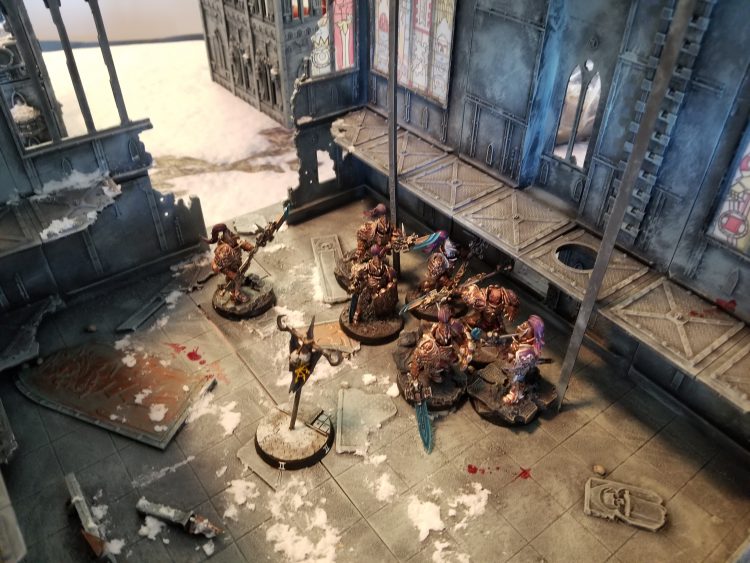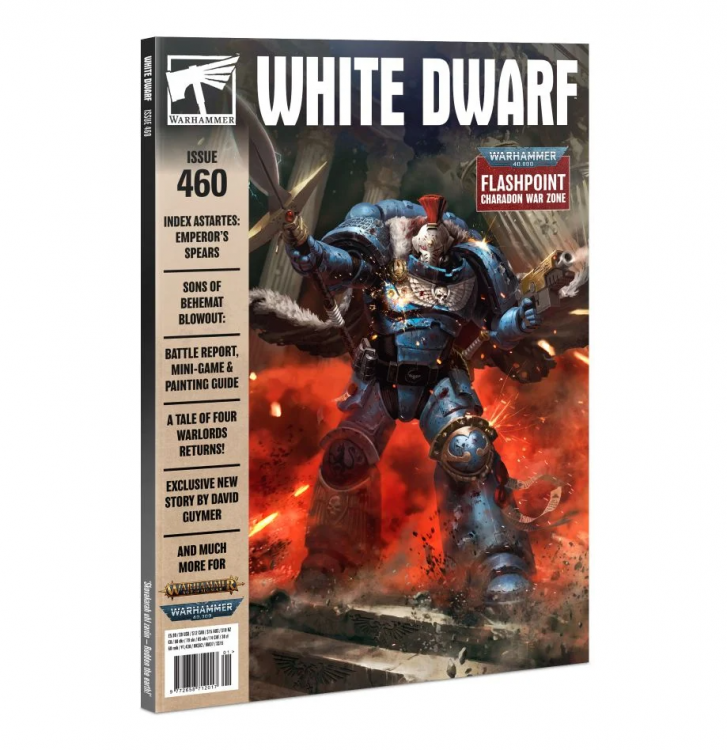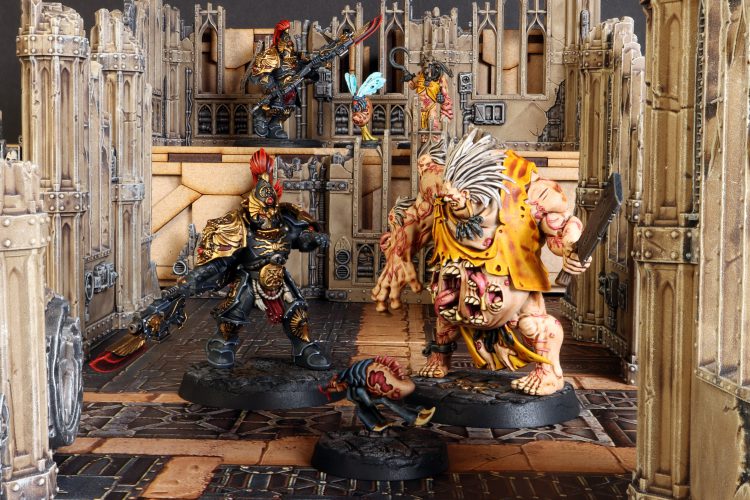In the Narrative Forge, we talk about playing games with more of a storytelling focus in mind. From bespoke missions to Crusade armies to sweeping campaigns, we cover the ways to add flavor to games. In today’s article, we’re reviewing the first set of rules for Flashpoints: Charadon from White Dwarf 460 – how they work, and whether they’re worth your time to try out.
Flashpoints are back! After wrapping up a three-issue series looking at Argovon, the series has set its sights on Charadon, soon to be the stage for the upcoming-but-possibly-should-have-already-been-out Charadon campaign book detailing the war between the Adeptus Mechanicus, Imperial Knights, and Death Guard. Oh and also the Drukhari are there or something. Spoiler: The Admech win, but at what cost?
If you missed our previous reviews of Flashpoints: Argovon (which ties into the Pariah Nexus and Beyond the Veil), you can check them out here:
Theatres of War
As with the previous Flashpoint, the Chromyd Front is set within a particular system in the larger Charadon warzone. As with many systems in the 40k setting, there are multiple planets of various strategic significance in play, and each one has its own flavor.
Okharium City Ruins
First up, the Okharium City Ruins let you fight through a bombed-out city, complete with booby traps, unexploded ordnance, and damage to the streets that will slow the process of moving across the battlefield.
- Bombed Battlefield – At the beginning of each battle, the Attacker will roll a d3 to see how bad the previous bombardments have been. If the city is more or less intact, the Untouched Roads will let you re-roll advance and charge rolls. On the other hand, if the streets have been damaged or there’s debris everywhere, you may find your vehicles having a harder time navigating the ruins, or your infantry may be able to hide in the debris as they move forwards.
- Booby Traps – That’s not all you’ll be dealing with, though: city fighting is notoriously dangerous, and the first time anyone steps into a piece of Building or Ruins terrain, there’s a 1-in-3 chance that it’s booby-trapped. This will result in that unit taking a Mortal Wound and possibly even rattled the unit enough to affect their shooting that turn.
- Unexploded Biologic Ordnance – But wait! There’s even more, you will also have to deal with up to 4 Unexploded Biologic Ordnance tokens that are also on the field. Over the course of the game, these will explode, unleashing their deadly payload creating a 12” bubble of stuff you probably don’t want to be standing in.
Rob: Another campaign setting, another set of battlezones that players will likely ignore. What I will say is that these battlezones break the mould a bit – it looks like GW have at least started to get away from the idea that a battlezone is a set of rules that cause random mortal wounds to a player’s units every turn. With some minor tweaks, Okharium City Ruins is a pretty good battlezone and in my opinion the best of the three options here. Not really because of the rules themselves, but moreso because of the ideas they’re trying to implement.
Beanith: Going by previous games using Afflictions from Beyond the Veil, it’s a bunch of special rules that my opponent and I won’t remember until at least midway through round 2, possibly round 3.
Rob: That’s always the challenge with tacking rules onto your campaigns. 40k is complicated enough without asking players to remember 3-4 environment rules that will only matter in a single mission and may change or be inactive during. It feels like each one of these would be more than enough for a mission effect but piling on all three is a bit much.
Condit: If nothing else, I’m glad that they decided to add some effects that aren’t just “roll on this table to see how many mortal wounds you take for being dumb enough to play this mission.”
Beanith: Unexploded Biologic Ordnance is a clear winner for me – four 12” bubbles which may or may not affect your plans on holding certain objectives or perhaps avoiding an area altogether. I’ll happily ignore Twisted Flora which might stop me from falling back on a 5+ but you can be sure I’m going to stay the hell away from Devouring Insects and its equivalent of Gets Hot.
Rob: Hard agree on the biologic ordnance – that’s a fantastic idea for a mechanic that can create genuine suspense during a game. What’s a big miss for me is that you then roll a random effect on a D6 table for each piece of ordnance and its explosion effect. This is one of the few times where I’d have been OK with some mortal wounds, or have it been mortal wounds and a -1 Toughness debuff. Having to track different effects on multiple bombs is too much and some of the effects just don’t really matter.
Condit: Maybe if you rolled for the type of ordnance at the start of the game and just used that for all of them?
Rob: Yeah, or even had one of the players choose, and had the other player attempting to disarm the bombs with an action for additional VP or Agenda XP. That’s probably a Goonhammer Approved waiting to happen.
Beanith: Booby Trap gets a pass because if you’re doing it right, you should have plenty of terrain on the board, which if you actually remember, might possibly cause a wound? What I don’t like is The Bombing Effect, it’s boring and having a 1-in-3 chance of getting the result of rerolling all charge and advance rolls makes going second quite painful. Maybe instead of rolling for the conditions before deployment, shift it to Step 13 where you resolve pre-battle abilities to make deployment a little more dicy?

Martyr’s Rest Mausoleum District
Next up is the Martyr’s Rest Mausoleum District, which gives you three random tables to apply to the game, giving random rules to every unit and terrain feature before the battle, and then implementing an additional random effect every turn.
- First, you’ll roll a d3 on the Spirits of the Dead table after determining Attacker and Defender. The effects here are simple: either a -1 to Ld for all units until they kill something, after which they get +1 to Ld, or the reverse. Oh, or if you roll a 1, nothing happens.
- Sanctified Blessings gives a bonus to Area Terrain pieces based on a d3 roll. You’ll either add 1 to Deny the Witch tests for units in the terrain, give units in the terrain a 4+ to ignore mortal wounds, or add 1 to rolls for Priests to chant litanies or pray.
- Finally, every round you’ll roll to see what the Voices in the Darkness do. These can change the range of your aura abilities, make Command Re-Roll free the first time you use it or completely unusable, or add or subtract 1 to Combat Attrition tests.
Beanith: Not everything can be a winner, see Greg and myself for an example. This Flashpoint is very much a dud on arrival for the most part. The Spirits of the Dead table with it’s +/- 1Ld is almost useless unless someone in your group is running Nightlords, in which case you might find this one interesting. Simple fix, make the Ld modifier stack and watch your units get more or less confident as the game progresses.
Rob: Right off the bat the Martyr’s Rest rubbed me the wrong way by having a table where a random effect was “nothing happens.” Why bother with these rules at all if there’s a chance they won’t matter?
Condit: To be fair, “Nothing happens” might be my favorite effect out of any of these tables.
Beanith: Unless you’ve got a lot of Psykers running around, Sanctified Blessings is the dumpster fire option of this Flashpoint. Of the three abilities when standing in area terrain, a 4+ FNP against Mortal Wounds is clearly the most useful for both sides for any army. Whereas adding 1 to Deny the Witch tests is only useful if you can in fact Deny at all. Quietening Consecration belongs in the bin, not only because it’s applicable to very few armies, typically if you’re running Chaplins or Dark Apostles you already have access to modifiers already.
Rob: These rules also don’t do anything to create a spooky or tense atmosphere in my mind, and too many of them just don’t matter. Hilariously if you play Death Guard you won’t have access to Dark Apostles or Priests so these rules don’t affect them.
Beanith: Honestly Voices in the Darkness would be the only reason I’d consider playing this particular flashpoint. A nice mix of good and bad effects that last for a round adds a nice bit of spice to the mix. I like the +/- 3” to auras and who doesn’t like the idea of a free Command Re-roll Stratagem once per round? Probably the same people who love the idea that Command Re-roll Stratagem cannot be used at all that round.

Dyroch’s Reach Desert Badlands
The Desert Badlands rule are designed to simulate fighting in a blistering, arid desert environment. There are three major components to this:
- Mineral Deposits, which are rolled for before the battle, are effects that change the map’s objective markers, essentially changing them into deposits of rare, important minerals. Each one of these has a specific in-game effect. The effects are primarily defensive buffs for units holding them and mostly make sense for their descriptions.’
- Cavernous Tunnel Network rules are designed to represent ancient tunnels below the battlefield created by bygone civilizations. Before deployment, players alternate placing cave entrance tokens on the battlefield. Units that end their Movement phase within 6” of one of these can head into the tunnels and show back up in the following turn’s Reinforcement step, albeit unable to charge and potentially suffering mortal wounds.
- Intolerable Heat are rules that model the effect of rising (and falling) temperatures on the battlefield. At the start of each battle round, players roll a D6, adding 1 if the heat level is tolerable and subtracting one if it’s already at max (solar flare). Higher results essentially represent greater heat levels, and make it more difficult to Advance, Charge, and hit targets at a distance.
Beanith: My favorite of the three Flashpoints by far. The Mineral Deposits are a great idea and make objectives less like a game of I’ve got more guys here than you do. I particularly like Glittering Silica as we all know that if something sparkles, it deserves a kicking.
Rob: Agreed. This is a strong concept, and has the strongest rules of the three. All three of these rules are interesting and give the game some interesting quirks that feel strongly connected to the fluff/flavor of the scenario. The Cavernous Tunnel network rules are probably the weakest part, but even those are interesting enough that I don’t mind.
Beanith: Cavernous Tunnel Network… did you want to play Genestealer Cult but not want to pay the ruinous prices that would entail collecting the army? This rule is for you. Interestingly enough it does look like you can use the tunnels to get out of combat at the risk of rolling a bunch of 1’s when you pop back up next turn.
Condit: The increased mobility at a cost is really cool, and will let you really pressure your opponents, especially if you’re playing a faction that isn’t “traditionally” very mobile.
Beanith: Intolerable Heat will be the chart I forget about until turn 2 or 3 which is a shame because it’s pretty… cool puts on sunglasses – caption: yeeeeeeeeeaaaaaaaaaahhhhh
Rob: Booo
Crusade Relics
In addition to the rules for playing in the Theatres of War, each one has a Crusade Relic that you can equip your Characters with. If your character would gain a Battle Trait and you just won a game in a Chromyd System Theatre of War, you can pick the relic that matches the Theatre you just played in to give to that character.
Martyr’s Rest offers the Warrior’s Bones, which let you re-roll a single hit roll, wound roll, or damage roll per turn, and adds a 1 to the re-roll. Could be handy in situations where you need to guarantee a kill, but it’s kinda weird that you don’t get the +1 to the first roll. If you just came from a trip to Dyroch’s Reach, you can bring back the Lost Archeo-Sights, which let you choose a Troops unit within 6” of the model with this relic and let it ignore any or all modifiers to hit, letting you bully aircraft or units in Dense Cover more effectively. Finally, the Okharium City Ruins relic, the Resilient Cuirass, makes the bearer immune to enemy aura effects and lowers the strength of incoming damage by 1.
Condit: I adore the Cuirass, largely because the fluff makes me suspect that whoever wrote this doesn’t realize that it absolutely does not do what they think it does. It claims that it “makes the wearer remarkably resilient to the hideous plague weaponry of the Death Guard,” then just…doesn’t have any effect on Contagions? Great work. Simply incredible, and I mean that literally.
Rob: Warrior’s Bones is a really interesting effect. It’s OK on hit/wound rolls where if you’re rolling a 3+ to hit your odds jump to 94% success versus 89% if you just had a 3+ re-rolling, but it really shines on damage rolls, where if you get a mediocre damage roll on say a Combi-Melta you can re-roll it with the assurance that your floor has increased from 3 to 4 at half range.
Beanith: Fine, leave me the Archeo-sights to talk about… well maybe slap it on the chump babysitting your Heavy Weapons? Very situational depending on what your local group is running for the most part. Take it to spite that Dark Angel chump with delusions of grandeur of being a proper army like Raven Guard.
Final Thoughts
Rob: These are off to a way better start than Argovon. They’re just more interesting rules, even when you consider Martyr’s Rest. The Unexploded Ordnance concept is an A+ concept with a C+ execution; the suspense of the bombs being ready to explode at any moment is great stuff but the actual effects of the bombs is so minor that you might not even care about the explosion! This is the ONE TIME I want to see random mortal wounds on one of these battlezone charts and it’s not there. Come on!
On a similar note, the Intolerable Heat rules for the Desert are pretty great conceptually. The temperature rising/falling mechanic is solid, though I’d rather see those swings be a bit less drastic; you can go from 1 to 6 pretty quickly. On the other hand again, the effects and execution leave a bit to be desired – the lower Advance/Charge rolls and lower chances to hit just make everything less deadly in a way that isn’t particularly compelling and some armies just may not even feel those effects to begin with.
There’s definitely some stuff worth stealing for my own campaigns here, and I might give these a shot at some point in the future. B-
Beanith: I’m with Rob, some good ideas found here but there’s way too much stuff mixed in that has zero effect on your army or just too fiddly. That said, there’s a stuff here I will also be stealing for The Crux Stars campaign that my group is running… which I’ve been meaning to write about one day when I get bored of Satisfactory (don’t tell Rob) B-
Condit: I could see myself playing in Dyroch’s Reach, and possibly the City Ruins if under duress, but Martyr’s Rest just doesn’t do it for me. The Unexploded Ordnance and Cavernous Tunnel Network are the two stand-out rules for me, and either of them would be cool concepts to build a mission around.
On the other hand, I think we’re off to a better start here than the Argovon Campaign, so I’m interested to see what comes next. B-
Have your own thoughts on how to use these missions or plans for playing in a Charadon campaign? Have feedback to share or questions? Drop us a note in the comments below or email us at contact@goonhammer.com.




